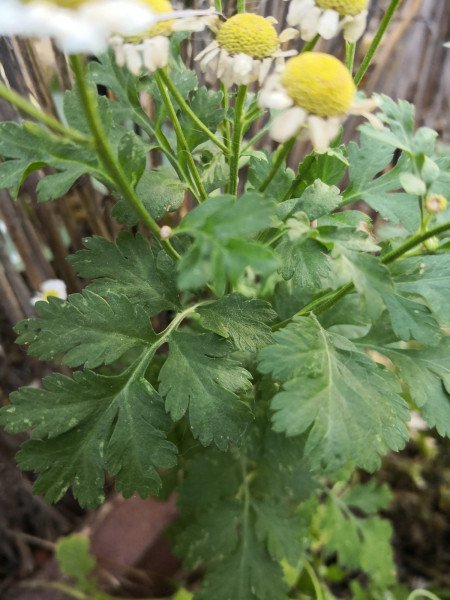Feverfew (Tanacetum parthenium)

Common names: Feverfew, Bachelor’s Buttons
Taxonomic name: Tanacetum parthenium
Family: Asteraceae
Uses: Migraines, headaches, biliousness, menstrual problems
Area of origin: Eurasia
Warnings: None
Feverfew (Tanacetum parthenium) is a close relative of the garden Chrysanthemum, in some books, you’ll even see it listed as Chrysanthemum parthenium.
It’s a very hardy plant. Ours lasts most of the year and grows every spring from seeds of the previous year’s crop. It’s so hardy that it prefers to grow in the gravel path rather than in the nice tasty garden beds.
The name ‘Feverfew’ comes from the Latin for ‘to drive away fevers’. Not surprisingly, one of its main uses is for just that – the driving out of fevers. Taken as a hot tea, Feverfew can reduce a fever through producing a sweat.
Feverfew is bitter and as you’ll know if you’ve explored this blog a little, bitters are so very, very good for us. They help move congestion and have a myriad of other positive effects on our body that begin but by no means end there. They’ll kick the gallbladder into producing bile and thus help the liver process fats and thus give us energy as they are digested better.
We don’t use Feverfew much for ourselves but keep it because of what is probably its best know modern application – migraines.

Feverfew is a preventative for migraines. Taken as a fresh leaf or two every day, Feverfew has been proven to reduce the frequency and severity of migraines. As so many folk suffer from these terrible things, we think its a great plant to have in our garden both as an example and ‘just in case’.
Taken the same way, it is good for vertigo – ‘very good for them that are giddie in the head‘ as it says in one old book.
In herbal terms, one can see Feverfew’s actions from the ailments that it helps with. Helping the digestion helps to relieve bloatedness and biliousness. The migraines that it helps with are those that are best described as congestion of the blood. Symptoms include a feeling of fullness in the forehead, pounding and throbbing (mainly in the left temple area) and a feeling of hotness in that temple.
Along the same line as congestion of blood in the head, Feverfew also acts in a similar way on the women’s reproductive system. Symptoms include congestion and fullness before the period, headache (of the type above), heavy and clotted bleeding
So Feverfew helps move congestion, particularly of blood and particularly in our head and female reproductive organs. This suggests that taking Feverfew as a preventative helps prevent this congestion in the first place.
Maybe I should take it more often.
Is feverfew a weed?
whats a weed?
A common plant, vigorous of growth, sometimes undervalued in society despite having benefits
Like the edible weed dandelion, for example
thats a good definition